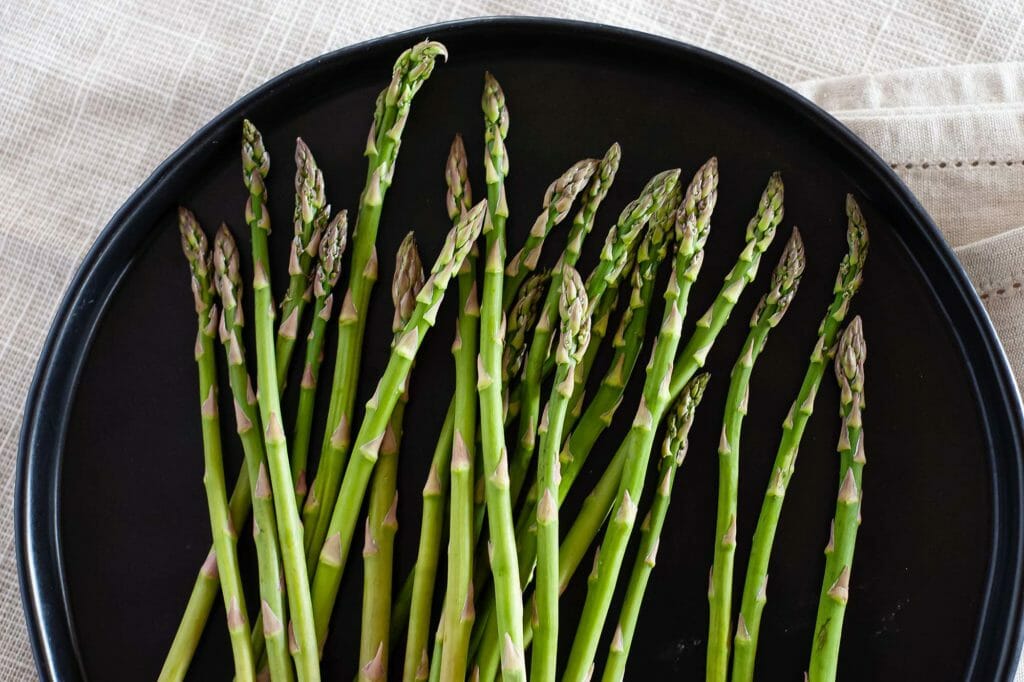Produce GuidesTipsAsparagus
Love asparagus? Pick the best bunch with these simple guidelines, then store it right so it’s ready when you are!
Print 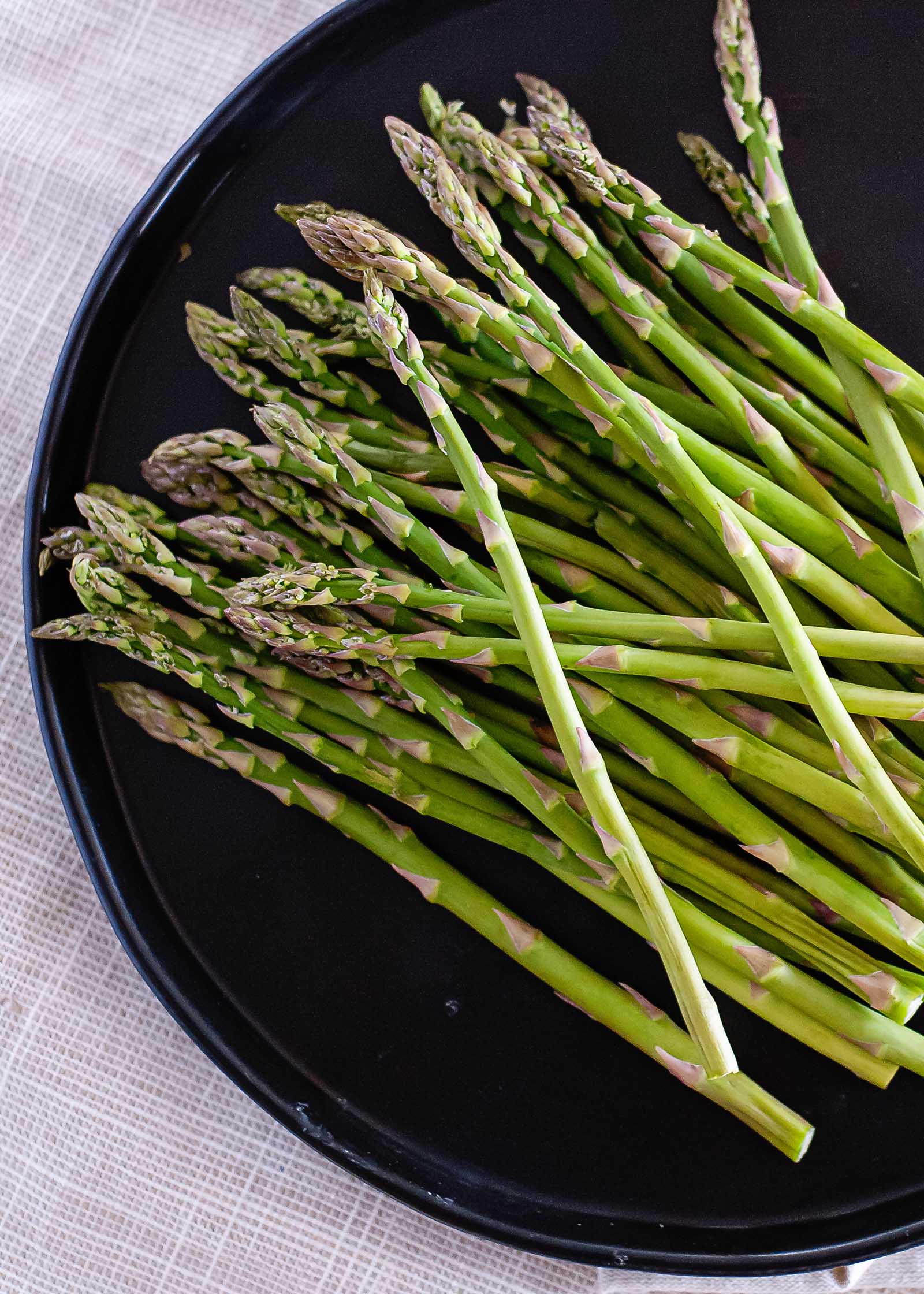
Asparagus rules! Are you with me here? Someone is, because worldwide consumption has grown steadily in the past ten years. What was once a seasonal crop is now available year-round in most grocery stores in the U.S.
But the fact remains: Spring is the best time to buy asparagus! If you find domestically-grown asparagus in the spring, snatch it up! Our farmers need your support, and let’s face it: Asparagus just tastes right in spring.
HOW TO CHOOSE ASPARAGUS AT THE STORE
Once upon time, most of America’s asparagus was grown in California, Washington, and Michigan. Now, the majority of asparagus we buy here is imported from Mexico and Peru.
Asparagus is technically “in season” in the spring and, accordingly, less expensive than scooping up a bunch in, say, November. However, growing conditions in South America favor year-round harvests, and that’s caused the price of asparagus to drop in what was once the off-season.
When looking at asparagus at the store, there are two things to look for:
- Is it fresh? You don’t want droopy or brittle, broken spears.
- Is it thick or thin? People tend to prefer one over the other—thick or thin.
1. Is it Fresh?
The first indicators of quality asparagus are the tips. They should be firm and springy, not tired-looking or semi-decomposed. If the tips are fresh, the rest of the spears likely are, too.
The stems should be resilient, not floppy or rubbery. Are the stem ends woody or shriveled? Woody is kind of okay; shriveled is not.
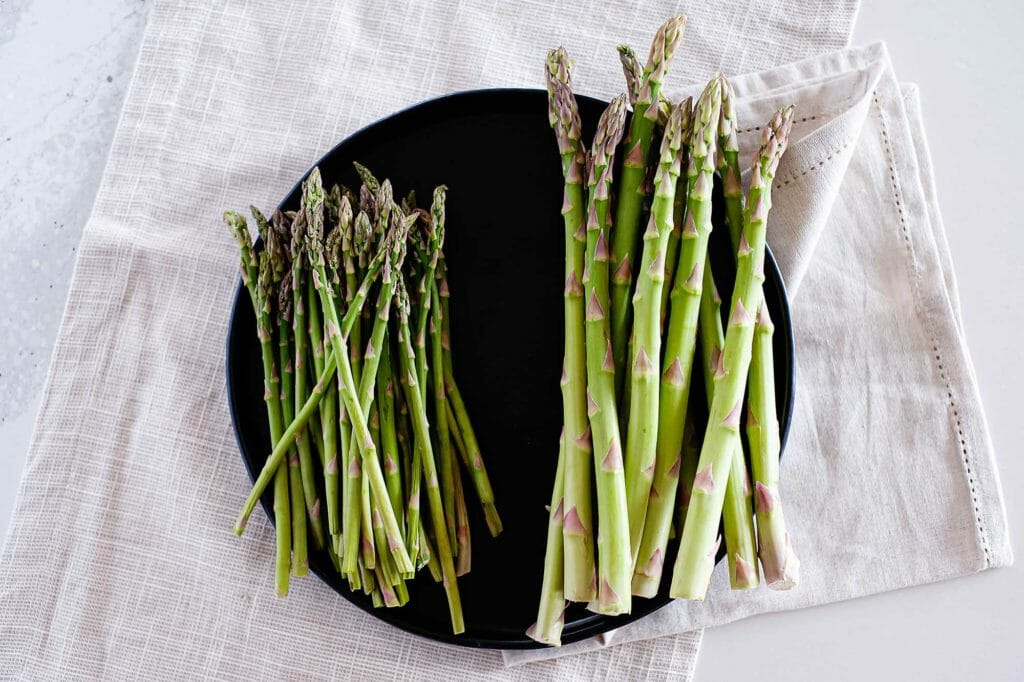
2. THICK OR THIN?
It’s all a matter of preference. Buy what you like.
- Thin asparagus, the kind that’s between the diameter of a pencil and a pinkie, has a greener, grassier taste. It cooks fast, is very easy to overcook, and isn’t great for grilling or roasting. Also, it does not last as long in the refrigerator, I’ve found.
- Thick asparagus is succulent, has a meatier texture, and tends to have a more developed “asparagus” flavor. It holds up to most any cooking method.
WHAT IS WHITE ASPARAGUS?
At fancier markets, you may see white or purple asparagus in addition to the typical green asparagus.
White asparagus is a delicacy in Europe, and beloved in Germany in particular. Its spears are thicker and squatter and, unlike green asparagus, the lower stems need to be peeled.
It’s white because growers mound up soil over it as it grows, so it doesn’t develop chlorophyll. Typically, white asparagus is boiled or poached and served in long spears with a sauce such as hollandaise.
WHAT IS PURPLE ASPARAGUS?
Purple asparagus is only purple on the outside, and that pretty color largely fades after cooking. Its flavor is somewhat sweeter than green asparagus. It has the highest level of antioxidants of all asparagus, in large part because of its abundance of anthocyanins (the pigment that makes it purple).
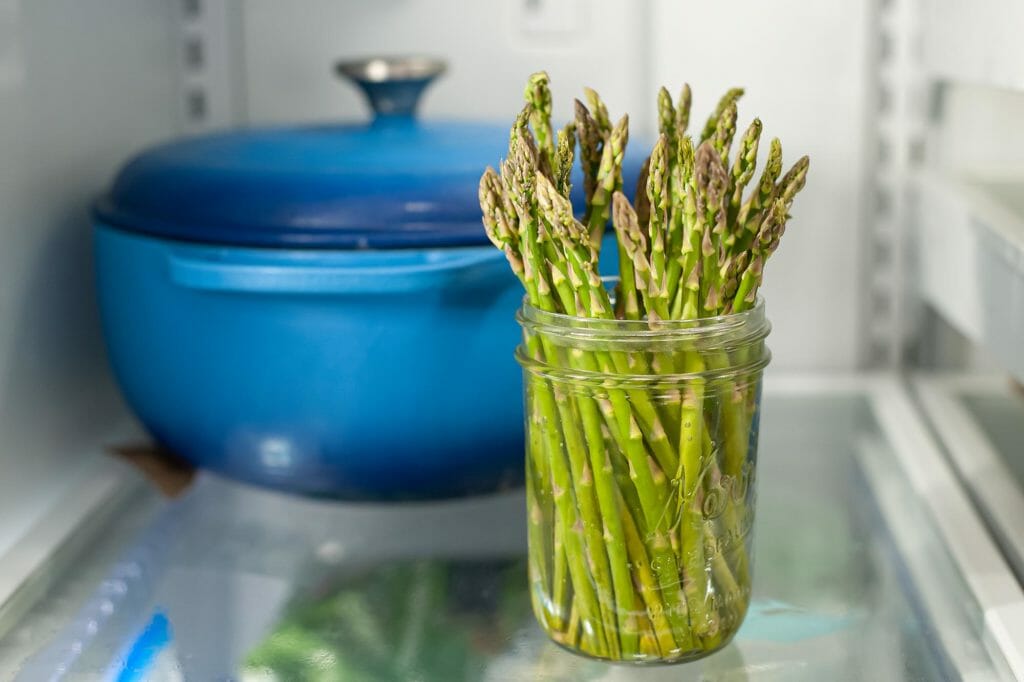
HOW TO STORE ASPARAGUS
First, remove the rubber bands holding the bunch together. Their pressure can make the asparagus spoil quicker. (Do you save the rubber bands from asparagus? Come on, they are the best rubber bands!)
Don’t rinse the asparagus until right before you plan to cook it. If the asparagus was packaged in a plastic bag, or wrapped on a Styrofoam tray, unwrap it.
The best way to store a bunch of asparagus is to treat it like a bouquet of flowers: trim about 1/2 inch off the ends and put it in a container of water. Unlike flowers, keep it in the fridge. This will extend the freshness of your asparagus a few days longer than simply keeping it in a bag.
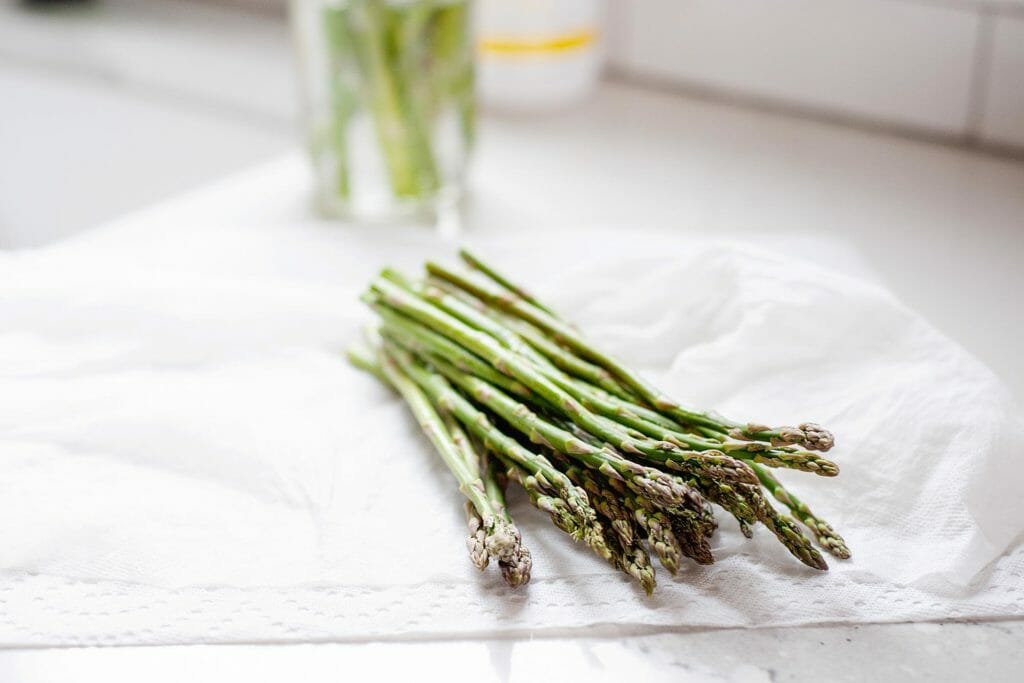
If you’re not in the mood to dig out an ad hoc asparagus vase, then wrap a damp paper towel around the bottom stems, put it in a plastic bag, and refrigerate it.
You can skip the paper towel thing, but do know your asparagus won’t last long if you cram it in a crisper drawer as-is once you’re home from the store. (This, by the way, is how I store my asparagus 99% of the time.) Unless your asparagus is quite fresh or hearty, the tips tend to get slimy faster in store packaging.
To minimize slime factor, it’s best to use asparagus within a few days of buying it. The tips are always the first part to go bad. If you have a bunch of asparagus that’s borderline, you can trim off the gooey parts and discard them, thereby salvaging the rest.
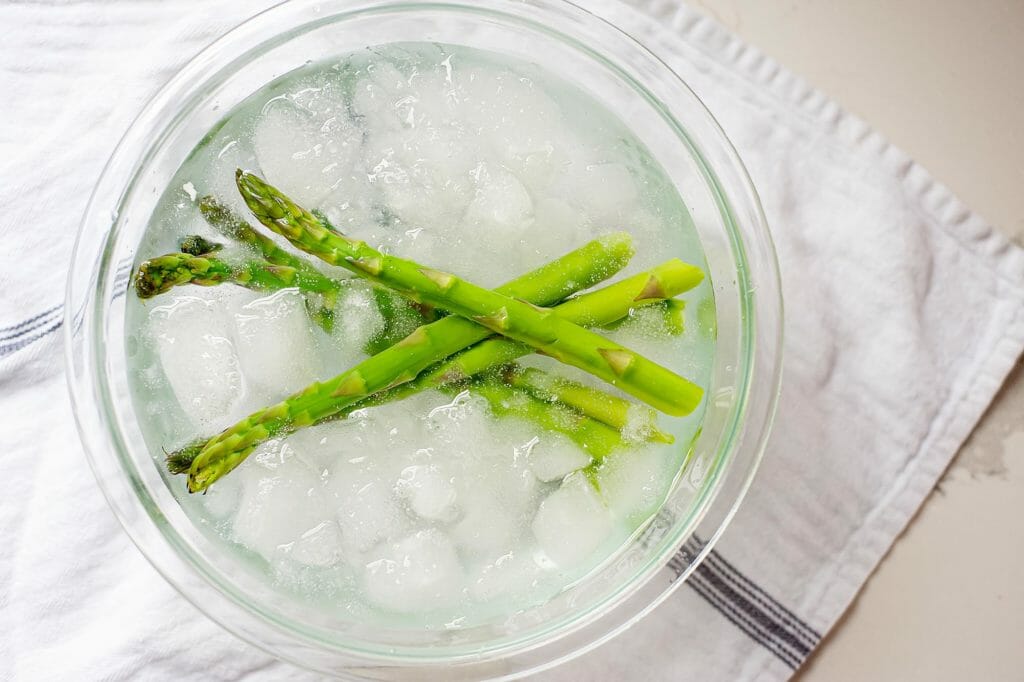
HOW TO FREEZE ASPARAGUS
You can freeze asparagus, but it’s best to briefly cook it first otherwise it will be mushy after thawing. Blanch it (one minute for thin stems; two minutes for thick) or steam it (four to five minutes, depending on the thickness of the stems), then shock it in ice water.
Drain it, pat it dry, and pack it into zip-top freezer bags. Label and date them; the asparagus will keep six months.
Best Substitutes for Asparagus
If a recipe calls for asparagus, but what’s at the store isn’t in great shape, just pass it up and substitute something else: broccolini, green beans, zucchini, whatever does look fresh. Of course, there’s no true substitute for asparagus. But there’s also no reason to settle for subpar spears.
One Last Note…
And finally, the pee thing.
Yes, eating asparagus makes your pee smell funny. Even the famous diarist Marcel Proust said “…asparagus transforms my chamber pot into a flask of perfume.” Interestingly enough, it turns out not everyone is able to discern this odor.
Asparagus Recipes to Try
- Prosciutto-Wrapped Asparagus
- Asparagus Pesto with Pasta
- Seared Scallops with Asparagus Sauce
Follow me on Pinterest
Products We Love
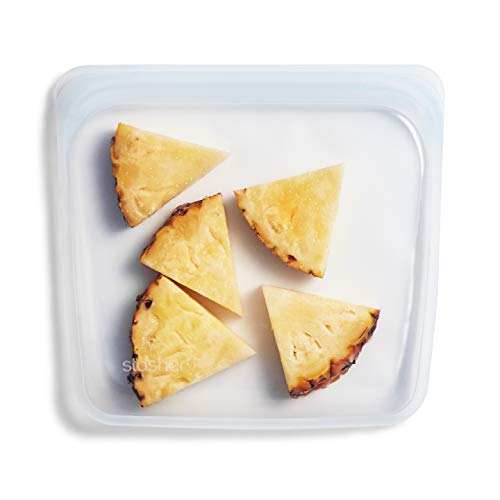
Stasher Bags
$11.97 on Amazon Buy
This post may contain links to Amazon or other partners; your purchases via these links can benefit Simply Recipes. Read more about our affiliate linking policy.
 Sara Bir
Sara Bir
Sara Bir a graduate of The Culinary Institute of America and the author of two cookbooks: The Fruit Forager’s Companion and Tasting Ohio. Past gigs include leading chocolate factory tours, slinging street cart sausages, and writing pop music criticism. Sara skates with her local roller derby team as Carrion the Librarian.
More from Sara



